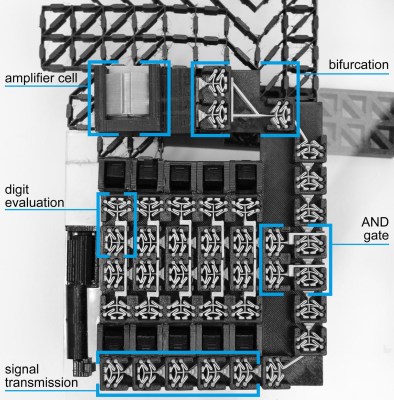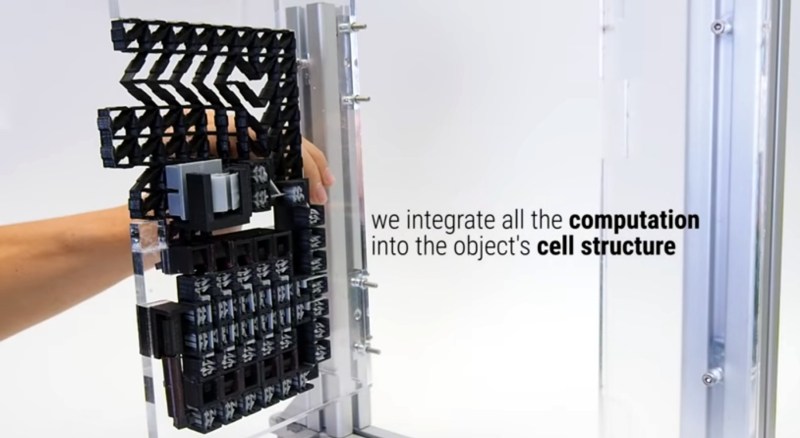3D printers are great for creating static objects, but if you’re clever, it’s possible to print functional devices. If you’re absolutely brilliant you can go far beyond that, which is the case here. This door handle with a key-code lock does it all with 3D printing using mechanism designs that look like alien technology. This is just one application of a much more interesting mechanical digital logic they’re developing (PDF).

Working from the [Hasso-Plattner-Institut], the research team is focusing on metamaterials as mechanisms in and of themselves. The crux of this lock is a series of bistable springs that — if the correct code is entered — will trigger in series to unlock the door. The project builds on the grid of shearing cells seen in the door handle we featured last year. It happens quickly in the video, but the intricate cascade of the handle unlocking is a treat to witness.
It’s a fascinating show of mechanical design. The common elements of digital electronics are all present: set or unset bits, logic gates, propagation issues, the whole works. But there are added challenges in this system, like the need for special cells that can turn the logic chain by 90 degrees and split the signal into more than one part.
This signal splitting is seen in the upper right (bifurcation) and leads into what is in effect an amplifier. The locking bolt must be moved twice the distance of a normal cell, so a dual-cell input is necessary to offset the loss of force from the incoming smaller cells. Cognitively we understand this, but we’re still trying to gain an intuitive sense of the amplifer mechanism.
One thing’s for sure, the overall concept is far cooler than this admittedly awesome door lock mechanism. The paper is worth your time for a deep dive. It mentions their design editor software. You can play with it online but we don’t think it’s been updated to include the new logic cells yet.
[Thanks for the tip, Itay!]















How long until we see a turing-complete machine with this technology?
Probably a good while, since that would actually require a way to supply power to said machine.
It has a way to supply power – you can crank a handle.
That only takes 32 gates, or less, not including the tape/memory so that is in itself not a big deal. The thing to note is the clock speed would mean than any useful computations would operate on a geological time scale, assuming the entire device did not break from fatigue when all of the plasticizers off-gassed after a few decades.
wind powered with a suitable gear ratio to run at a decent speed? (sort of like the strandbeest of computers!)
Yeah or some sort of computational butt plug….
Where do I learn more about a 32 gate -or less- turing-complete machine?
You can learn the theory here, http://www.complex-systems.com/index.html then study some computer science or electrical engineering and the rest becomes obvious.
urh, studied physics, … enjoyed a course called Dynamical Systems, read some books like Strogatz’, studied computer science on my own as well, … I may not have persevered long enough, but could you just be helpful and show me where I can find a 32 gate turing complete machine? I would really appreciate it. Closest I can find is 28 ICs (89 Gates, with various input sizes) http://www.6502.org/users/dieter/m14500/m14500.htm
I would really appreciate an explicit reference, and it doesn’t have to be built IRL, even theoretical models (discrete time, boolean variables instead of real voltages etc) are fine, just lowest gate count
FFS work it out your self if you are so well educated. I seriously doubt the your honesty as I find it hard to believe you could not know such basic stuff.
What is the truth table for the smallest Universal Turing Machine, what is the logic gate arrangement that embodies that logic. There was a schematic posted in the comments on HAD within the last few years and in more recent times people here have even woken up to the fact that any Boolean function’s look up table can be represented by a ROM built using just diodes (a point made by the person who posted that first diagram), this was also demonstrated comprehensively in an article here more recently. See the Gray-1
So anyway the lowest gate count is actually zero, a ROM will do it, but if you do use gates it is as I said under 32. In fact you can do the core logic with 8 NOR gates, or 4 NAND and an inverter. But you need buffers and timing logic too. There is also the option to have a set of shift registers interacting such that the data in one becomes the address select for the output from another etc. in a loop. This interaction of data and address values in a self modifying memory forms a completely virtual state machine of whatever configuration you like because you can implement a UTM which then emulates all other TMs.
The reason it works is that you are pushing all of the complexity out into the memory which can be a huge shift register, but there are many other options and media that can be used, including light where addressing is a phase shift in the read timing of an optical loop.
Computers operate in Space-Time you can use a lot of one or the other or a combination of the both but the end result and “cost” is the same.
This is basic computer science knowledge, if you don’t know it then you know very little about computer science indeed! So back to the books for you.
The following videos illustrate several fundamental aspects of Turing machines that I have mentioned above including the concept of “cost” and how the number of states can always be reduced to 2 at the price of maximising the computational steps. Higher levels, greater numbers of states (symbols) is the equivalent of physical parallelism so you are moving into using up space rather than time.
https://www.youtube.com/watch?v=Rt_SfOkk0YM
https://www.youtube.com/watch?v=QtO8EWwggx4
This seems like it would be a good technology to apply to children’s toys. A safe is perhaps the worst application for plastics. -_-
Well, jello would be worse. But I get your point. :)
Perhaps a safe constructed of open air?
Air-gapped safes would be difficult to access.
I present the invisible safe! Totally secure and only visible to smart people!
I’m guessing it comes with these royal robes that are inside it?
it may have one plus: due to the almsot complete lack of resonant frequencies in plastics, it would be super hard to go safe cracking with a stethoscope and a keen ear ;)
They should upgrade their on-line programming/design tool to so that people can import Minecraft projects. There seem to be lots of logic mechanisms already designed in Minecraft. eg:
http://www.pcgamer.com/minecraft-player-creates-word-processor-out-of-redstone/
http://www.escapistmagazine.com/news/view/109385-Computer-Built-in-Minecraft-Has-RAM-Performs-Division
What about Minetest? It’s open source and it has logic gates and microcontrollers which can be programmed in Lua (through a mod called Mesecons).
World saves are SQLite or LevelDB database files, so importing them should be easy. There could be a mod (also programmed in Lua) to do that in-game, too.
http://www.minetest.net
http://www.mesecons.net
“logic gates and microcontrollers which can be programmed in Lua (through a mod called Mesecons).”
This is true of Minecraft too.
To answer your question, it’s the same reason why Raspberry Pi still beats out all its cheaper or superior competition. Community support is everything.
Yay, now I can implement rod logic from Diamond Age. Now imagine fpga made with those cells…
The FPGA would be a bucket full of small plastic bits with strange shapes. Yes, it would have to be programmed (and actually built) by hand. Diamond Age had no HDL and JTAG dongles…
Pick and place machines?
Diamond Age was my first thought, too. You should be able to build nanoscale bistable latches…
“3D printers are great for creating static objects, but if you’re clever, it’s possible to print a functional devices.”
Remove the ‘a’ please, it’s the first line..
Got it, thanks.
No, no, put the a back and remove the plural s.
;-p
>”Cognitively we understand this, but we’re still trying to gain an intuitive sense of the amplifer mechanism.”
It operates by releasing stored energy in the bit cell. One input triggers two bistable springs.
The energy is recharged when the user turns the handle and resets the bit cells.
https://www.youtube.com/watch?v=y97rBdSYbkg
Boom!
I wasn’t aware of Stephen Morris’ channel, very interesting stuff!